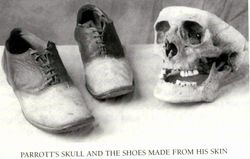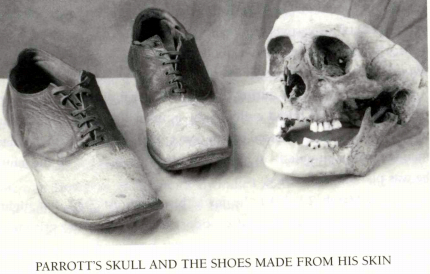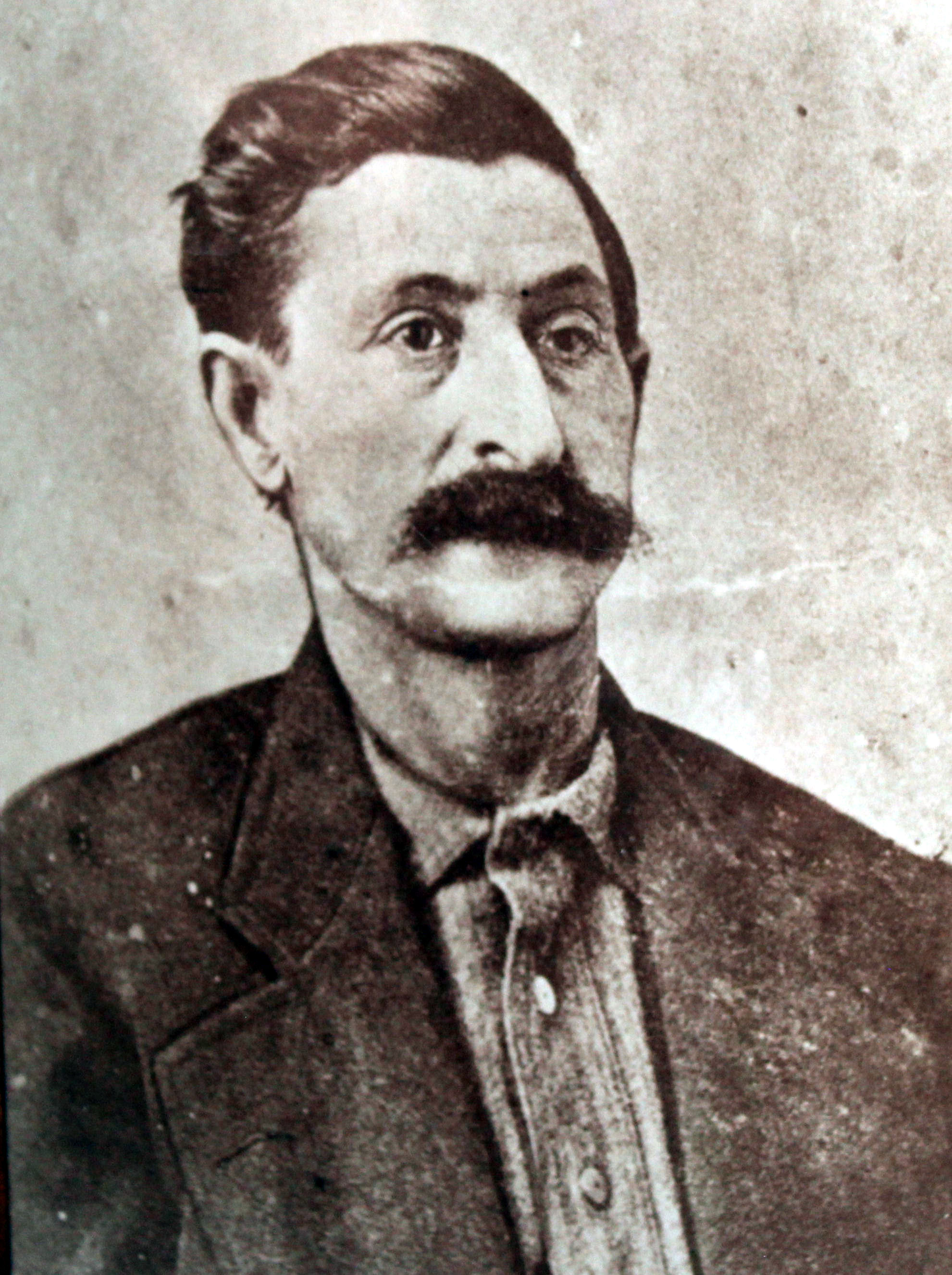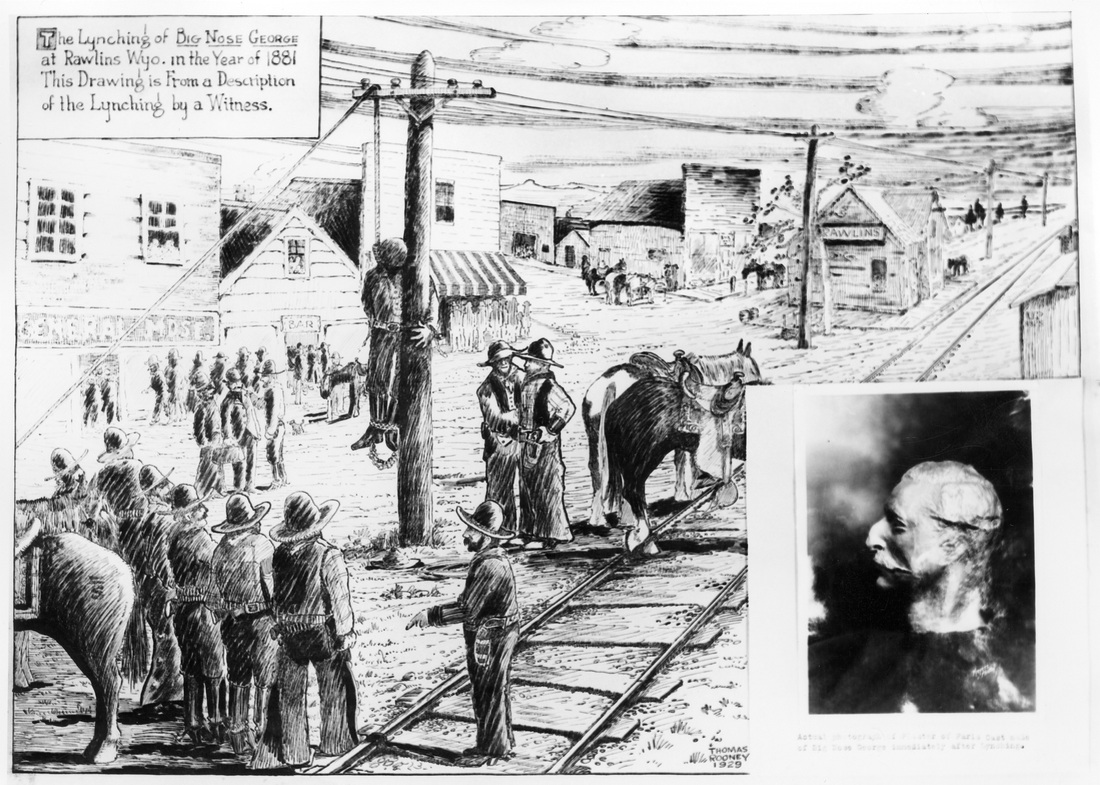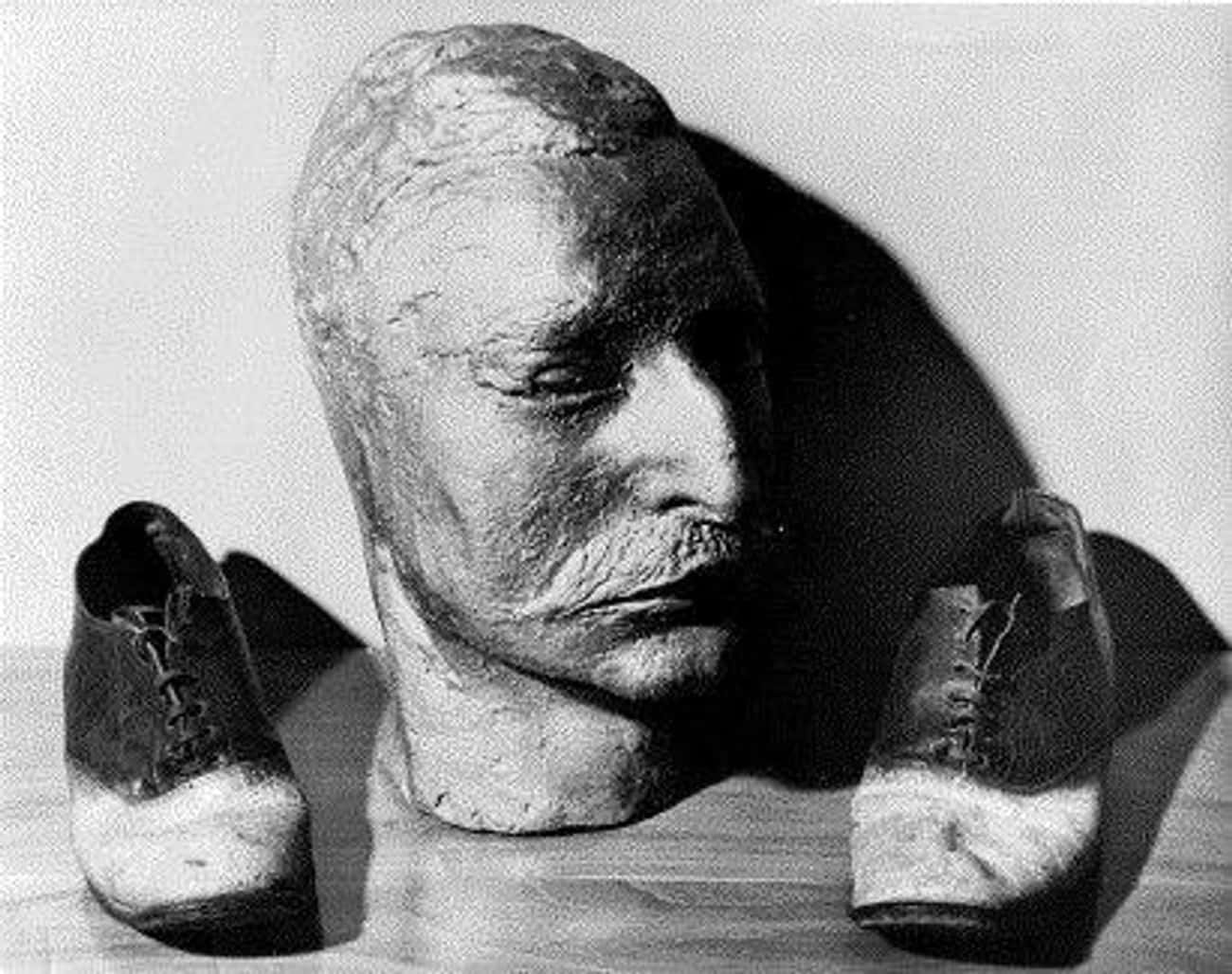In 1881, George Parrott, a cattle rustler popularly known as Big Nose George, was lynched in Rawlins, Wyoming.
Parrott was notable for "Banditry, Murder, being made into a pair of shoes." Oh, and being pickled.
The series of events that lead to Parrott's death began on August 19, 1878, when he and his gang tried to wreck a train near Medicine Bow, Wyoming so they could rob it. They loosened a rail and waited patiently, but an alert section foreman spotted the loose rail and notified railroad authorities, who came and fixed it before the train arrived.
Realizing the law would be after them, Parrott's gang fled toward Elk Mountain and hid in Rattlesnake Canyon, waiting to ambush the posse they knew would be coming.
As soon as the lawmen were within their rifle sights, the bandits opened fire. Parrott killed Tip Vincent Henry H "Tip" Vincents
, a Union Pacific Railroad agent; one of the other fugitives, "Dutch" Charley Bates Charlie "Dutch Charley" Burris
, killed Deputy Sheriff Robert Widdowfield Robert Widdowfield
The gang then fled and hid out in Montana for a span, eventually reaching Canada — and all the while continuing their criminal ways.
Parrott couldn't keep his mouth shut about his outlaw exploits and bragged everywhere he went. Inevitably, someone who'd heard one of his stories went to Rawlins and happened to mention the hook-nosed man who'd tried to derail a train, then killed two people when their plan failed.
"Dutch" Charley Bates was arrested in Green River, Wyoming in December 1878 and put on a train bound for Rawlins to face trial. Ironically, it was the same train he'd tried to derail earlier that year.
But Bates never made it to Rawlins: when the train made a stop at Carbon City, a group of masked vigilantes overpowered Bates's guards, hauled him off the train, forced him to confess to his crimes and then hoisted him up on a rope to slowly strangle to death.
Parrott remained at large and the reward for his capture grew to $2,000 before his big mouth got him into trouble again. He and his gang had held up several stagecoaches and pulled off a particularly lucrative job in July 1880. He bragged about it to a lady friend, who told other people, and eventually word reached the ears of the Rawlins sheriff. Within hours he was under arrest.
In a repeat of the Bates lynching, a posse forced Parrott from his Rawlins-bound train in Carbon City. R. Michael Wilson, in his book Frontier Justice in the Wild West, writes what happened next:
They escorted him onto the station platform, put a noose around his neck, yanked him up, then lowered him and asked for a full confession. When he hesitated the men pulled him up several times and then promised that if he confessed, he would be given a fair trial — but if he did not confess, he would be hung. Parrott talked, and once he began, he gave every detail of his various criminal ventures, some of which were quite a surprise to the vigilantes. The mob, true to their word, then returned the prisoner to the custody of Sheriff Rankin.
That's touching behavior for a vigilante mob, but it sure feels like Carbon City could stand to tighten up its railroad security.
At any rate, Parrott was tried for Tip Vincent's murder in the fall of 1880, convicted, and sentenced to death.
However, on March 20, 1881, thirteen days before he was scheduled to hang, he made a desperate escape attempt. Though Parrott managed to knock Sheriff Rankin unconscious, Mrs. Rankin foiled the breakout by locking up the cells before Parrott could get out. Extra guards were assigned to watch him after that.
As Wilson records,
Sheriff Rankin asked the townsmen to wait the short time remaining before the prisoner was to be legally hanged, but the general opinion was that the sheriff had taken enough abuse from the prisoner and that Parrott might yet escape if left to await his fate on April 2. On March 22 at 10:55 p.m., a party of thirty masked men went to the jail and removed Parrott. They marched him to the telegraph pole … A rope was placed over the crossbeam of a telegraph pole, the noose was secured around the prisoner's neck, and Parrott was forced to stand upon a barrel. Parrott begged piteously to be shot and cried out that it was cruel to hang him, but his pleas were ignored.
They kicked the barrel out from under him, but it was too short: the rope and Parrott's neck stretched enough so that his toes touched the ground.
The mob cut him down and went and got a ladder. Parrott climbed it and said he would jump off and break his neck, but as far as the vigilantes were concerned, that was too good for him: they pulled the ladder away instead, and he slowly strangled to death, tearing off one of his ears in the process.
Drs. Thomas Maghee Dr Thomas Gillis Maghee
and John Eugene Osborne John Eugene Osborne
conducted the autopsy, examined Parrott's brain, and could find no apparent abnormalities. Osborne then removed a large piece of skin from the dead man's chest, kept the skullcap, and put the rest of the body in a whiskey barrel full of saline solution, effectively pickling it. The barrel was buried without ceremony, and Dr. Osborne had the skin tanned. He sent the leather to a shoemaker, who made him a pair of shoes with it.
Dr. Osborne was disappointed that Parrott's nipples weren't on the tips of the toes like he'd requested.
skull was crudely sawn off, and the cap was presented to 15-year-old Lillian Heath Dr Lillian Evelyn Heath Nelson
, then a medical assistant to Maghee. Heath became the first female doctor in Wyoming and is said to have used the cap as an ash tray, a pen holder and a doorstop A death mask was also created of Parrott's face, and skin from his thighs and chest was removed. The skin, including the dead man's nipples, was sent to a tannery in Denver, where it was made into a pair of shoes and a medical bag. They were kept by Osborne, who wore the shoes to his inaugural ball after being elected as the first Democratic Governor of the State of Wyoming. Parrott's dismembered body was stored in a whiskey barrel filled with a salt solution for about a year, while the experiments continued, until he was buried in the yard behind Maghee's office
He wore the human leather shoes on special occasions, including at his inaugural ball when he was elected governor of Wyoming in 1890.
The death of Big Nose George faded into history over the years until May 11, 1950, when construction workers unearthed a whiskey barrel filled with bones while working on the Rawlins National Bank on Cedar Street in Rawlins. Inside the barrel was a skull with the top sawed off, a bottle of vegetable compound, and the shoes said to have been made from Parrott's thigh flesh. Dr. Lillian Heath, then in her eighties, was contacted and her skull cap was sent to the scene. It was found to fit the skull in the barrel perfectly, and DNA testing later confirmed the remains were those of Big Nose George. Today the shoes made from the skin of Big Nose George are on permanent display at the Carbon County Museum in Rawlins, together with the bottom part of the outlaw's skull and Big Nose George's earless death mask. The shackles used during the hanging of the outlaw, as well as the skull cap, are on show at the Union Pacific Museum in Omaha, Nebraska. The medicine bag made from his skin has never been found
http://en.wikipedia.org/wiki/Big_Nose_George
http://www.executedtoday.com/2013/03/22/1882-george-parrott-rawlins-lynched/
Frontier Justice in the Wild West: Bungled, Bizarre, and Fascinating Executions by R. Michael Wilson
In 1881, George Parrott, a cattle rustler popularly known as Big Nose George, was lynched in Rawlins, Wyoming.
Parrott was notable for "Banditry, Murder, being made into a pair of shoes." Oh, and being pickled.
The series of events that lead to Parrott's death began on August 19, 1878, when he and his gang tried to wreck a train near Medicine Bow, Wyoming so they could rob it. They loosened a rail and waited patiently, but an alert section foreman spotted the loose rail and notified railroad authorities, who came and fixed it before the train arrived.
Realizing the law would be after them, Parrott's gang fled toward Elk Mountain and hid in Rattlesnake Canyon, waiting to ambush the posse they knew would be coming.
As soon as the lawmen were within their rifle sights, the bandits opened fire. Parrott killed Tip Vincent Henry H "Tip" Vincents
, a Union Pacific Railroad agent; one of the other fugitives, "Dutch" Charley Bates Charlie "Dutch Charley" Burris
, killed Deputy Sheriff Robert Widdowfield Robert Widdowfield
The gang then fled and hid out in Montana for a span, eventually reaching Canada — and all the while continuing their criminal ways.
Parrott couldn't keep his mouth shut about his outlaw exploits and bragged everywhere he went. Inevitably, someone who'd heard one of his stories went to Rawlins and happened to mention the hook-nosed man who'd tried to derail a train, then killed two people when their plan failed.
"Dutch" Charley Bates was arrested in Green River, Wyoming in December 1878 and put on a train bound for Rawlins to face trial. Ironically, it was the same train he'd tried to derail earlier that year.
But Bates never made it to Rawlins: when the train made a stop at Carbon City, a group of masked vigilantes overpowered Bates's guards, hauled him off the train, forced him to confess to his crimes and then hoisted him up on a rope to slowly strangle to death.
Parrott remained at large and the reward for his capture grew to $2,000 before his big mouth got him into trouble again. He and his gang had held up several stagecoaches and pulled off a particularly lucrative job in July 1880. He bragged about it to a lady friend, who told other people, and eventually word reached the ears of the Rawlins sheriff. Within hours he was under arrest.
In a repeat of the Bates lynching, a posse forced Parrott from his Rawlins-bound train in Carbon City. R. Michael Wilson, in his book Frontier Justice in the Wild West, writes what happened next:
They escorted him onto the station platform, put a noose around his neck, yanked him up, then lowered him and asked for a full confession. When he hesitated the men pulled him up several times and then promised that if he confessed, he would be given a fair trial — but if he did not confess, he would be hung. Parrott talked, and once he began, he gave every detail of his various criminal ventures, some of which were quite a surprise to the vigilantes. The mob, true to their word, then returned the prisoner to the custody of Sheriff Rankin.
That's touching behavior for a vigilante mob, but it sure feels like Carbon City could stand to tighten up its railroad security.
At any rate, Parrott was tried for Tip Vincent's murder in the fall of 1880, convicted, and sentenced to death.
However, on March 20, 1881, thirteen days before he was scheduled to hang, he made a desperate escape attempt. Though Parrott managed to knock Sheriff Rankin unconscious, Mrs. Rankin foiled the breakout by locking up the cells before Parrott could get out. Extra guards were assigned to watch him after that.
As Wilson records,
Sheriff Rankin asked the townsmen to wait the short time remaining before the prisoner was to be legally hanged, but the general opinion was that the sheriff had taken enough abuse from the prisoner and that Parrott might yet escape if left to await his fate on April 2. On March 22 at 10:55 p.m., a party of thirty masked men went to the jail and removed Parrott. They marched him to the telegraph pole … A rope was placed over the crossbeam of a telegraph pole, the noose was secured around the prisoner's neck, and Parrott was forced to stand upon a barrel. Parrott begged piteously to be shot and cried out that it was cruel to hang him, but his pleas were ignored.
They kicked the barrel out from under him, but it was too short: the rope and Parrott's neck stretched enough so that his toes touched the ground.
The mob cut him down and went and got a ladder. Parrott climbed it and said he would jump off and break his neck, but as far as the vigilantes were concerned, that was too good for him: they pulled the ladder away instead, and he slowly strangled to death, tearing off one of his ears in the process.
Drs. Thomas Maghee Dr Thomas Gillis Maghee
and John Eugene Osborne John Eugene Osborne
conducted the autopsy, examined Parrott's brain, and could find no apparent abnormalities. Osborne then removed a large piece of skin from the dead man's chest, kept the skullcap, and put the rest of the body in a whiskey barrel full of saline solution, effectively pickling it. The barrel was buried without ceremony, and Dr. Osborne had the skin tanned. He sent the leather to a shoemaker, who made him a pair of shoes with it.
Dr. Osborne was disappointed that Parrott's nipples weren't on the tips of the toes like he'd requested.
skull was crudely sawn off, and the cap was presented to 15-year-old Lillian Heath Dr Lillian Evelyn Heath Nelson
, then a medical assistant to Maghee. Heath became the first female doctor in Wyoming and is said to have used the cap as an ash tray, a pen holder and a doorstop A death mask was also created of Parrott's face, and skin from his thighs and chest was removed. The skin, including the dead man's nipples, was sent to a tannery in Denver, where it was made into a pair of shoes and a medical bag. They were kept by Osborne, who wore the shoes to his inaugural ball after being elected as the first Democratic Governor of the State of Wyoming. Parrott's dismembered body was stored in a whiskey barrel filled with a salt solution for about a year, while the experiments continued, until he was buried in the yard behind Maghee's office
He wore the human leather shoes on special occasions, including at his inaugural ball when he was elected governor of Wyoming in 1890.
The death of Big Nose George faded into history over the years until May 11, 1950, when construction workers unearthed a whiskey barrel filled with bones while working on the Rawlins National Bank on Cedar Street in Rawlins. Inside the barrel was a skull with the top sawed off, a bottle of vegetable compound, and the shoes said to have been made from Parrott's thigh flesh. Dr. Lillian Heath, then in her eighties, was contacted and her skull cap was sent to the scene. It was found to fit the skull in the barrel perfectly, and DNA testing later confirmed the remains were those of Big Nose George. Today the shoes made from the skin of Big Nose George are on permanent display at the Carbon County Museum in Rawlins, together with the bottom part of the outlaw's skull and Big Nose George's earless death mask. The shackles used during the hanging of the outlaw, as well as the skull cap, are on show at the Union Pacific Museum in Omaha, Nebraska. The medicine bag made from his skin has never been found
http://en.wikipedia.org/wiki/Big_Nose_George
http://www.executedtoday.com/2013/03/22/1882-george-parrott-rawlins-lynched/
Frontier Justice in the Wild West: Bungled, Bizarre, and Fascinating Executions by R. Michael Wilson
Advertisement
Records on Ancestry
Advertisement
